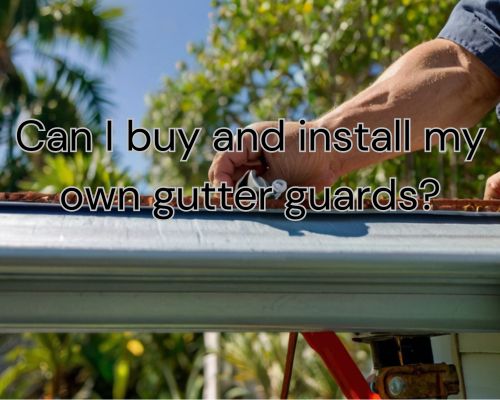Gutter guards are a popular solution for homeowners looking to maintain their home’s integrity. Installing gutter guards yourself might seem daunting. But, it’s actually a manageable DIY project with the right tools and guidance.

Yes, you can buy and install your own gutter guards, potentially saving money while protecting your home from water damage.
When deciding to tackle this project, consider the different types of gutter guards available and which will best suit your needs.
Foam inserts, such as the Gutterstuff Original K-style, are straightforward to install and effective in keeping out leaves and debris.
Looking into different options gives you the flexibility to choose what works best for your home and budget.
DIY installation of gutter guards can be done with basic household tools. Clear, sunny weather is ideal for installing these guards, ensuring safety and efficiency.
With the right approach, you can enhance your home’s protection against clogs and overflows. Let us get to know more with Mike Owen from Gutters Of West Palm Beach.
Evaluating Gutter Guard Options
When choosing gutter guards, you’ll need to consider the type of guard, the materials used, and the measurements required for your specific gutters. Here’s a detailed look at these aspects to help you make an informed decision.
Understanding Different Types of Gutter Guards
There are several types of gutter guards to choose from, each offering different benefits and drawbacks.
Mesh gutter guards feature fine screens that block most debris, including small leaves and pine needles.
Reverse curve gutter guards use surface tension to direct water into the gutter while keeping debris out.
Screen gutter guards are basic but effective, with large perforations to filter out larger debris.
Brush gutter guards consist of bristle-filled brushes that trap leaves and twigs but allow water to flow.
Finally, foam gutter guards are inserts that fit snugly into the gutter, blocking debris on the surface.
Selecting the Right Material
The materials of your gutter guards significantly impact their performance and durability.
High-quality aluminum and steel options are robust and resistant to rust, making them ideal for long-term use.
Plastic or PVC guards are lightweight and easy to install but may degrade over time due to UV exposure.
Foam guards are cheaper and simpler to install but typically require more frequent replacement.
Your choice should consider the local climate, the type of debris commonly encountered, and your budget.
Measuring and Preparation
Accurate measurements are critical for a successful installation.
Start by measuring the length of your gutters using a tape measure. Ensure you also account for the width of your gutters and the slope of your roof.
Purchasing gutter guards that fit your dimensions avoids costly mistakes and ensures proper fitment.
Preparation might include clearing existing debris from the gutters and checking for any damages to the shingles or roofing that may impede the guards’ efficacy.
Installation and Maintenance
Proper installation and regular maintenance of gutter guards are crucial to ensuring they function effectively. You have the choice between taking the do-it-yourself route or hiring professionals, each with its own set of considerations and benefits.
Do-it-Yourself Installation
DIY installation of gutter guards can be a practical choice for homeowners who enjoy tackling home improvement projects.
For installing gutter guards, you’ll need basic tools like a screwdriver, hammer, and a sturdy ladder.
Start by cleaning your gutters thoroughly to ensure no debris is caught underneath the guards, which could lead to clogs.
Next, measure the length of your gutters to determine how much material is needed. Follow the manufacturer’s installation instructions carefully; this generally includes attaching the guards with screws or clips.
Leaf guards, foam inserts, and screens are popular options for those interested in DIY installation. This is because they have easy installation and are effective in preventing clogs.
Remember to wear safety gear and take precautions when working at heights.
Professional Installation and Services
If climbing a ladder and handling tools isn’t your forte, opting for professional gutter guard installation might be the best route.
Professional installers like Mike Owen from Gutters Of West Palm Beach, come with the expertise and equipment to ensure the job is done correctly and safely.
They often guarantee their work, which can give you peace of mind about the performance and durability of your new gutter guards.
Some companies provide cleaning services as part of their package, addressing any existing clogs and ensuring optimal water flow.
Prices for professional installations vary but generally range from $3.00 to $7.00 per linear foot, depending on the type of guards and complexity of the job.
Ongoing Gutter Maintenance
Even with gutter guards, ongoing maintenance is necessary to keep your system in top condition.
Regularly inspect your gutters to ensure they remain free of debris that could bypass the guards.
Using a leaf blower, water hose, or even by hand, you should periodically clean the guards to prevent any buildup that might impede water flow.
Some gutters may still develop minor clogs from fine particles or persistent leaves. For these instances, periodic cleaning services can assist in maintaining peak performance.
Consistent inspections and occasional cleanings will enhance the longevity of your gutter system, providing effective prevention against water damage.